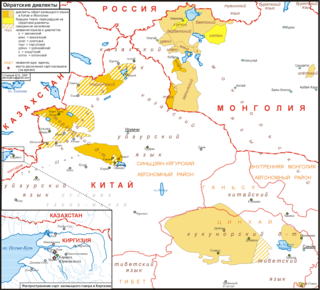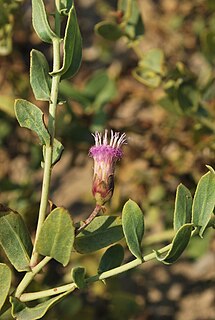
Hyssopus (hyssop) is a genus of herbaceous or semi-woody plants in the family Lamiaceae, native from the east Mediterranean to central Asia as far east as Mongolia. They are aromatic, with erect branched stems up to 60 cm long covered with fine hairs at the tips. The leaves are narrow oblong, 2–5 cm long. The small blue flowers are borne on the upper part of the branches during summer. By far the best-known species is the herb hyssop, widely cultivated outside its native area in the Mediterranean.
Altay or Altai is a mountain range in East-Central Asia, where Russia, China, Mongolia and Kazakhstan come together.

Adenophora is a genus of flowering plants in the family Campanulaceae, the bellflowers. Plants of this genus are known commonly as ladybells. Most are native to eastern Asia, with a few in Europe. Many are endemic to either China or Siberia.

Leymus is a genus of plants in the grass family Poaceae (Gramineae). It is widespread across Europe, Asia, and the Americas.

Oirat is a Mongolic language spoken in Central and East Asia. Scholars differ as to whether they regard Oirat as a distinct language or a major dialect of the Mongolian language. Oirat-speaking areas are scattered across the far west of Mongolia, the northwest of People's Republic of China and Russia's Caspian coast, where its major variety is Kalmyk. In China, it is spoken mainly in Xinjiang, but also among the Deed Mongol of Qinghai and Subei County in Gansu.

Leonurus is a genus of flowering plants in the family Lamiaceae. It is native to Europe and Asia, naturalized in New Zealand, Hawaii, New Caledonia, and much of North and South America.

Rhaponticum, is a genus of flowering plants in the thistle tribe within the sunflower family.

The gray marmot, grey marmot, or Altai marmot is a species of rodent in the squirrel family Sciuridae. It is one of the larger marmots in the genus Marmota. It occurs in mountainous grasslands and shrub lands of central Asia, and is one of the 9 Palearctic (Eurasia) species. It is found in Xinjiang Province in China, southeastern Kazakhstan, Kyrgyzstan, Mongolia, and in the Altai and Tien Shan Mountains in southeastern Siberia in Russia. In the Mongolian Altai, its range overlaps with that of the Tarbagan marmot. Gray marmots form social groups, live in burrows, and hibernate.

The alpine pika is a species of small mammal in the pika family, Ochotonidae. The summer pelage of different subspecies varies drastically but, in general, it is dark or cinnamon brown, turning to grey with a yellowish tinge during the winter. The alpine pika is found in western Mongolia, eastern Kazakhstan, and Russia, as well as in China, in very cold, mountainous regions. It is a generalist herbivore, and mainly forages on mosses, tree branches, pine nuts, and plant stems. It can emit three series of different vocalizations: a long call, a short call, and an alarm call. It is rated as a species of least concern on the IUCN Red List of Endangered Species.

Pan-Mongolism is an irredentist idea that advocates cultural and political solidarity of Mongols. The proposed territory, called "Greater Mongolia", usually includes the independent state of Mongolia, the Chinese regions of Inner Mongolia and Dzungaria, and the Russian republic of Buryatia. Sometimes Tuva, the Altai Republic and parts of Zabaykalsky Krai and Irkutsk Oblast are included as well. As of 2006, all areas in Greater Mongolia except Mongolia have non-Mongol majorities.

Khüiten Peak is the highest peak with 4,356 m above sea level and a permanent snow cap in the Altai Range, the international border between China and Mongolia runs across its summit point. It is also the highest point of Mongolia and Altay Prefecture in Western China.

Kobresia is a genus of plants in the sedge family. They are sometimes called bog sedges. These perennial sedges are quite similar to Carex species in appearance. The genus is widespread across much of Europe, Asia and North America, with many species native to the Himalayas.

The Altai Uriankhai refers to a Mongol tribe around the Altai Mountains that was organized by the Qing dynasty. They now form a subgroup in western Mongolia and eastern Xinjiang.

Karelinia is a genus of flowering plants in the daisy family.

Ptilagrostis is a genus of grasses in the family Poaceae. They are distributed in Asia and North America. They are known commonly as false needlegrasses.
The Altai-Sayan region is an area of central Asia proximate to the Altai Mountains and the Sayan Mountains, near to where Russia, China, Mongolia and Kazakhstan come together. This region is one of the world centers of temperate plant diversity. Its biological, landscape, historical, cultural and religious diversity is unique. 3,726 species of vascular plants are registered in the region including 700 threatened or rare species, 317 of which are endemic; fauna consists of 680 species, 6% of which are endemic. Its ecosystem is comparatively unchanged since the last ice age, and it is the host of endangered species that include the saiga, nerpa, and snow leopard. It is the focus of ongoing international and regional environmental conservation initiatives.
Allium amphibolum is a species of onion native to Altai, Tuva, Kazakhstan, Mongolia, and the Province of Xinjiang in western China.
Lagopsis is a genus of the mint family, first described in 1835. It is native to Siberia, China, Mongolia, and Central Asia.
- Lagopsis darwinianaPjak - Mongolia
- Lagopsis eriostachya(Benth.) Ikonn.-Gal. - Tuva, Irkutsk, Mongolia, Xinjiang, Qinghai
- Lagopsis flavaKar. & Kir. - Xinjiang, Kazakhstan, Kyrgyzstan
- Lagopsis marrubiastrum(Stephan) Ikonn.-Gal. - Altai Republic in Siberia, Ladakh Range of Tibet and Kashmir
- Lagopsis supina(Steph. ex Willd.) Ikonn.-Gal. - China, Mongolia, Siberia
Craniospermum is a genus of flowering plants in the family Boraginaceae, native to Kazakhstan, the Altai, Siberia, Mongolia, and Xinjiang and Inner Mongolia in China. They are tuft-forming biennial or perennial herbs, and are generally highly endemic, thought to be relicts of the hypothesized ancient Mediterranean flora.

Stipa lessingiana, called Lessing feather grass, is a species of flowering plant in the genus Stipa, found in steppes from Greece east to Mongolia, including the countries bordering the Black and Caspian Seas, Central Asia, western Siberia, the Altai, and Xinjiang in China. It has gained the Royal Horticultural Society's Award of Garden Merit.














